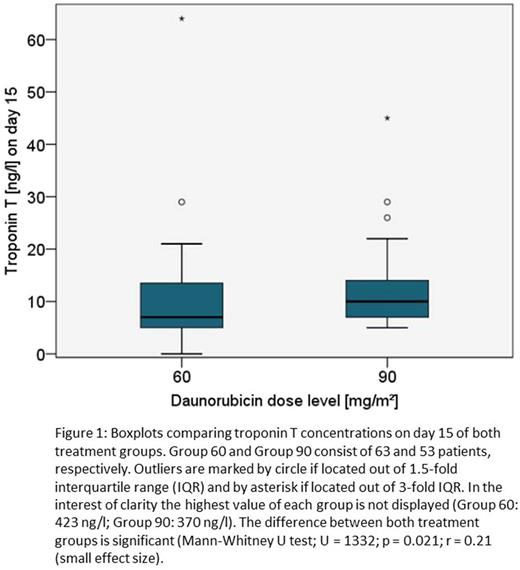Abstract
Introduction : Induction therapy for acute myeloid leukemia (AML) based on 7 days of cytarabine and 3 days of anthracycline has been standard treatment for decades. However, the optimal dose level of anthracycline is still in question. This issue is addressed by the ongoing randomized controlled DaunoDouble trial comparing 60 mg/m² versus 90 mg/m² in standard 7+3 induction for patients with newly diagnosed AML (NCT02140242). Since cardiotoxicity is considered the most dangerous side effect of anthracyclines, we compared serum levels of cardiac markers between the two study arms in the course of chemotherapy and afterwards.
Methods: Serum concentrations of NT-proBNP and cardiac troponin T were measured prior to induction therapy (day 0), before (day 2) and during daunorubicin administration (days 3, 4, 5) and on day 15. The induction treatment consisted of a 7+3 induction with daunorubicin at a dose of either 60 or 90 mg/m² (Group 60 and 90). By the time of analysis, data on highly sensitive measured troponin T concentrations at day 15 was available for 116 patients.
Results: With regard to NT-proBNP concentrations no significant difference between study arms was found, but NT-proBNP levels of Group 90 remained constantly higher during daunorubicin administration. Whereas there was no considerable development concerning troponin T during induction therapy, at day 15 the median troponin T concentration of all patients was 8 ng/l and as such significantly higher compared to 5 ng/l before daunorubicin administration (Wilcoxon test; Z = -3.763; p < 0.001; r = 0.38 (medium effect size)). The proportion of patients with troponin T concentrations higher than 14 ng/l, which is the 99%-percentile of the healthy population, was 9.78 percent [95% CI: 3.60 - 15.97%] before daunorubicin administration and 16.50 percent [95% CI: 9.21 - 23.80%] on day 15. Significant correlations occurred between troponin T concentrations on day 15 and pre-treatment values of troponin T (Spearman's ρ = 0.502; p < 0.001) and NT-proBNP (Spearman's ρ = 0.245; p = 0.02). Prior to daunorubicin application, the median troponin T concentration was 5 ng/l in Group 60 and 6 ng/l in Group 90, respectively. On day 15, Group 90 had significantly higher troponin levels (ctrop, Group 90, median = 10 ng/l) than Group 60 (ctrop, Group 60, median = 7ng/l; Mann-Whitney U test; U = 1332; p = 0.021; r = 0.21 (small effect size)). The proportion of patients with troponin T concentrations higher than 14 ng/l was 14.55 percent [95% CI: 4.93 - 24.16%] in Group 60 and 18.75 percent [95% CI: 7.30 - 30.20%] in Group 90.
Conclusion: Prospective cardiac monitoring of a large number of patients with identical disease and treatment shows that the cardiac impairment of daunorubicin administration during AML induction therapy resulted in a significant shift to higher troponin T levels. Patients within Group 90 had significant higher troponin T concentrations on day 15 with an average increase of 3 ng/l compared to Group 60. With respect to the prognostic value of troponin T (cf. ARIC study, CHS study), a higher risk of future cardiac complications could be assumed for Group 90. Long-term follow-up is necessary to draw more precise conclusions on the clinical impact of the cardiac marker kinetics.
Stoelzel: medac: Other: Travel support. Mayer: Novartis: Research Funding; Eisai: Research Funding. Hochhaus: Pfizer: Research Funding; Novartis: Research Funding; Incyte: Research Funding; BMS: Research Funding; ARIAD: Research Funding; MSD: Research Funding. Rollig: Janssen: Research Funding; Bayer: Research Funding.
Author notes
Asterisk with author names denotes non-ASH members.


This feature is available to Subscribers Only
Sign In or Create an Account Close Modal